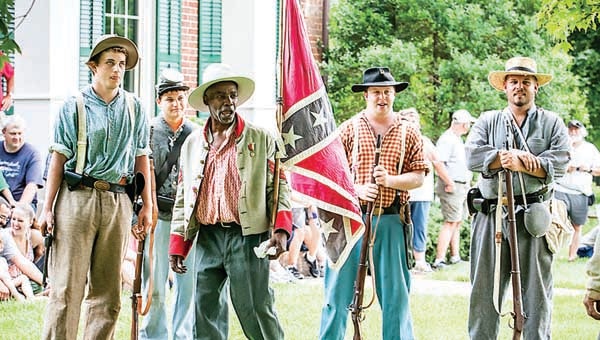Civil War re-enactment brings history to life at Brooks Farm
Published 9:07 am Wednesday, July 22, 2015

Star File Photo
Re-enactors re-create the Battle of Brooks Farm in 2013. This year’s re-enactment will be held Saturday and Sunday.
The 12th Tennessee Cavalry will present an authentic re-creation of one of the most defining times in American history when the Battle of Brooks Farm takes place this weekend on Blue Springs Road.
Programs Saturday and Sunday will begin at 10 a.m. Spectators will be able to wander throughout the camps and speak to the troops and examine their weapons, including cannons and horses. The weekend of activities also will feature a tour of the Stover House, which was re-located to the Brooks property several years ago by Dr. Daniel Schumaier, who owns Brooks Farm.
The Stover house, built in 1797, was owned by President Andrew Johnson’s daughter, Mary, and was originally located in the Lynn Valley area. President Johnson suffered a stroke and died in the house while visiting his daughter.
Grant Hardin, who portrays Bill Wilson, a guerilla fighter, says the weekend is “really all about history” and how the Civil War affected Carter County and the surrounding region. “Carter County’s sentiments were with the Union, however, there were quite a few Confederate sympathizers in the country and Reuben Brooks was one of them,” Hardin said.
“The Brooks farmstead is a stately old place. There’s a lot of history surrounding that old farm and house,” Hardin said.
The house, located at 1548 Blue Springs Road off Highway 91, was built in 1820. It was placed on the Tennessee and National Register of Historic Places after much research by the present owner, Dr. Schumaier.
According to his research, the property was a reward to John Michael Smithpeters for his military efforts during the Revolutionary War in 1777. The property was later sold to Reuben Brooks. To obtain labor for the large farm, the Brooks family became slaveholders.
“Slavery was not very popular in this end of the state, however, there were quite a few slave owners in the county, including some who were sympathetic to the Union cause,” said Hardin. “Most of the slave owners were very good to their slaves and treated them like family.”
The property passed to Reuben Brooks, Jr., born in 1814. He married Mary Smithpeters in 1834, and they had seven children. Neither Reuben, Jr. nor his eldest son, William, would survive the Civil War. Active in politics, Reuben was also a member of the secessionist movement. When Reuben died, his son, William took up the cause. He began recruiting men for the Confederate cause and was soon commissioned a First Lieutenant.
His recruitment efforts let to his untimely death. Young William was shot by Union sympathizers as he rode up Stoney Creek. He was taken to an upstairs bedroom in the Brooks home, where he died from his wounds. The floor in the bedroom where he died is still stained with his blood.
Hardin, who enjoys the Civil War re-enactments, said he has no qualms about participating in the weekend battle and the display of the Confederate flag despite the recent controversy about the shooting deaths of nine black church members in South Carolina.
“What that Confederate flag represents to me is not the idea of slavery nor hatred. It’s the men that left their homes to fight versus the invading Union (troops), attacking their way of life.” Hardin said.
“We need to portray history accurately. If you take away the flag, it’s not accurate. It’s part of history. There were slaves and there was a battle fought, numerous battles and skirmishes, not just here in Carter County, but all over the south.
“It wouldn’t have been all that uncommon to see slaves working the fields nor to have seen Confederate soldiers camped around the Brooks farms during the Civil War era,” said Hardin.
“During the Civil War, Carter County was split politically. It wasn’t heavily populated at the time, so there wasn’t a lot of fighting except skirmishing and guerilla warfare. The Brooks farm became the headquarters of the Confederacy here in Carter County. It was a very important place, because people that had Confederate leanings, and ever irregulars stopped here. There’s a lot of history that has taken place on that farm,” Hardin said.
While the Battle of Brooks Farm never really took place, the skirmishes and other fights that took place on and around the property served as the inspiration for the annual re-enactment, including the fight that led to the death of William Brooks on July 1, 1863.
Hardin said re-enactments are some of the most educational ways of teaching people how the country was formed and the difficult times it has endured.
“Compared to other countries, we are quite young, but we’ve had our share of wars and difficulties,” Hardin said. “We fought the Civil War. And, even though we had a division big enough to cause such a horrendous war as it was, we still came together and built a great nation that sent a man to the moon and has made all kinds of medical advances.:
Admission to the re-enactment is $4. Children under five will be admitted free.
Proceeds will go to St. Jude Children’s Hospital in Memphis.




